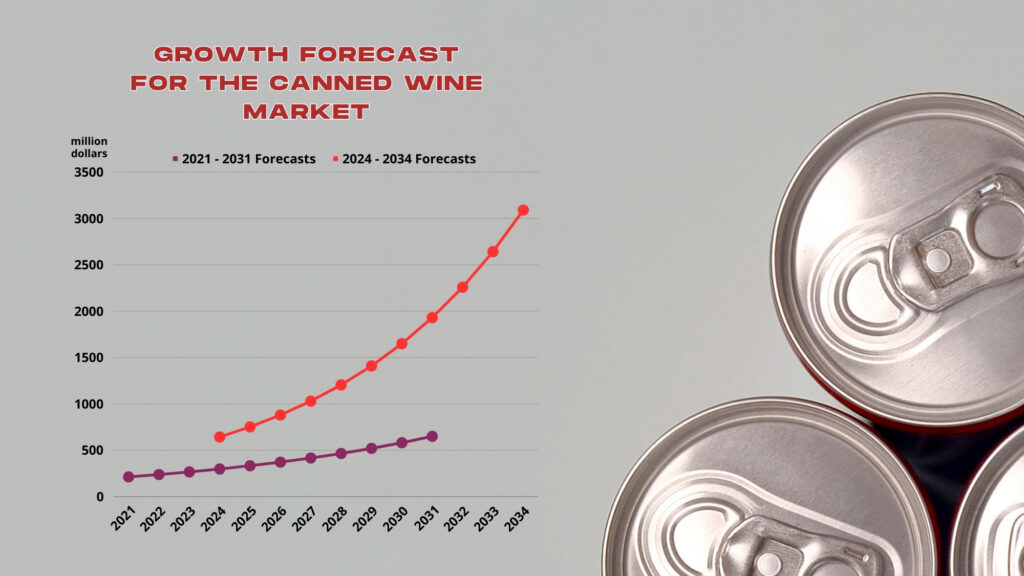Let’s all stay calm, don’t wrinkle your nose, but the market trend says it: canned wine will change the future of wine. Increasingly, the search for new wine packaging solutions seems to focus on cans to reduce wine production costs and significantly cut the environmental impact of the entire industry.
There’s certainly some skepticism about this proposal because the glass bottle has always represented a status symbol, and the various shapes of the bottle strongly characterize the type and quality of the wine. Not to mention the presence of the label, a covering that for centuries has allowed wineries to present the wine and their brand. But let’s take it step by step and try to understand the canned wine trend.
Figures and Trend
Canned wine is certainly not a new concept. It has been on the market for years and has particularly gained traction in countries with less traditional (or traditionalist, one might say) wine industries. The idea of drinking wine from containers other than glass is not new either, infact, there is a wide range of wine available in carton containers. However, cans still horrify wine lovers.

According to a market research published in 2021, the global canned wine market was valued at $213.42 million, with an expected annual growth rate of 11.8%. It was anticipated to reach a global value of $592.90 million by 2031.
The truth is, by 2024, the canned wine market had already exceeded growth expectations, reaching a value of $643 million. According to a second study published in November 2023, forecasts predict a total value of $3,129 million by 2034. So, whether we like it or not, it’s a solution we’ll see more and more often.
Environmental Awareness and Growing Demand for Canned Wine
In an article on this blog, we analyzed the environmental impact of wine production, quiting a commendable study conducted by Argiano that found bottle production to be the most resource-intensive point in the entire wine supply chain. The primary reason companies and distributors are shifting towards cans is to reduce their environmental impact and production costs.

A case in point is the supermarket chain Waitrose, one of the largest in the UK, which, by selling wine under its private label, has decided to use glass for smaller-sized wine packages. This would involve replacing over 3 million glass bottles with 3 million cans.
This is the same approach that will be used in Sweden, where there is a state monopoly on the sale of alcohol. The public company responsible for this, Systembolaget, has stated its intention to reduce its environmental impact by focusing on alternative packaging, including wine in cartons, TetraPak, and of course, cans.
The reason is simple: glass is very environmentally costly at the time of production. Even glass disposal is unsustainable because it does not allow for complete recycling of the raw material, while aluminum from cans can be infinitely recycled, and its production is significantly less costly.
New Generations and New Consumption Occasions
Demographic changes in different regions of the world are important factors influencing the canned wine market. The increasing presence of millennials and the young population is reshaping the alcoholic beverages market. Over the last two decades, there has been a significant transition in alcohol consumption among millennials worldwide. Millennials are more conscious of their alcohol consumption and are also redefining wine consumption occasions.

The on-the-go drinking culture of the new generations of thirty-somethings and twenty-somethings is boosting canned wine sales. The sharp rise in its popularity among millennials has led to a massive increase in the number of key market players launching or revising their brands for new wine consumption occasions such as outdoor events, picnics, or beach outings. For it to be consumed in these occasions, wine must be transported in lighter and less fragile containers. The can is perfect for this, as it also allows for the purchase of a quantity suitable for the individual drinker.
Canned Wine in Italy
We’ve talked about the UK and Sweden, but of course, it’s already an established reality in the United States. And what about Italy? We all know about wine in TetraPak packaging and bags with attached dispensing taps. However, in Italy, wine in cans has been around for a while.
In 1978, the Giacobazzi Winery in Modena applied to package wine in alternative containers. In 1982, it began packaging wine in cans and other alternative containers. The permission granted was short-lived and did not allow the winery to continue production to meet already significant demand at the time.
Today, other companies like the Donelli Vini Group, Cantina Sgarzi Luigi, and Zai Urban Winery continue down this path, also reaching out to new generations of consumers.
In Italy, however, there is a limit imposed by the production regulations of DOC and DOCG wines, which require bottling in traditional-sized bottles that respect established usage, and containers of “fancy design” are excluded (Article 22.1).
“It is forbidden to use materials other than glass, crystal, porcelain, and wood for containers up to five liters” (Article 22.2).
Change Is Underway
It’s a monumental shift in consumption patterns because wine is losing its place on the table to become a quicker and less contemplative consumption experience. What wines will win this challenge? Which ones will be most suitable for the new packaging?














